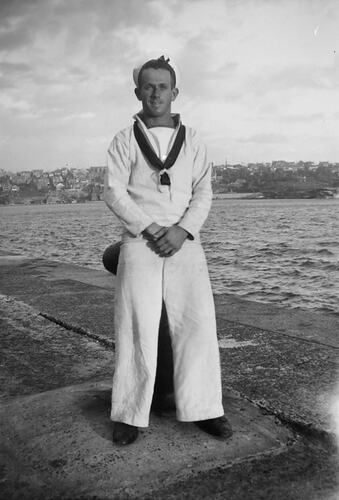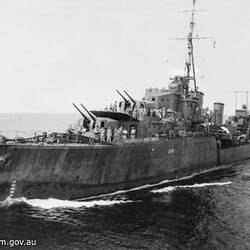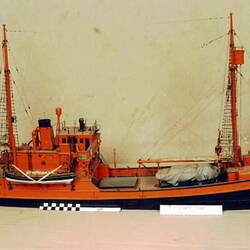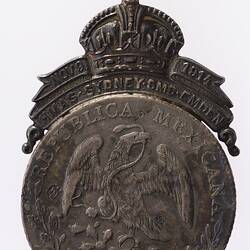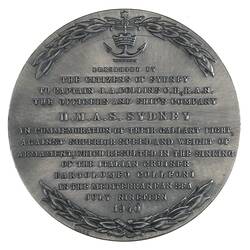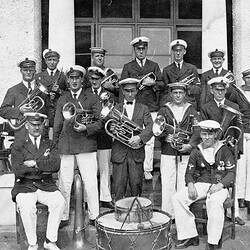Just over ten years after Australian Federation, the Permanent Naval Forces of the Commonwealth became the Royal Australian Navy (RAN) on 10 July 1911. While the formation of the RAN was widely viewed as a significant statement of the growing maturity of a young nation, the RAN largely adopted its uniforms, equipment, regulations and many personnel from the Royal Navy (RN) which formally handed over control on 1 July 1913. The RAN was responsible for the protection of the Australia Station and would form a unit of the Royal Navy in the event of war. By the beginning of the First Word War in August 1914, the RAN fleet included the battlecruiser HMAS Australia, the light cruisers Sydney & Melbourne as well as two submarines and three River Class torpedo boat destroyers. Cockatoo Island dockyard in Sydney provided essential ship-building and maintenance support. The RAN College for officer training was initially established at Osbourne House at Geelong, Victoria before being transferred to HMAS Creswell at Jervis Bay, NSW in 1915.
The Imperial German navy threatened the sea routes around Australia using bases and coaling stations in China, New Guinea and Samoa. The German East Asiatic Squadron was a powerful force of cruisers capable of disrupting trade and naval operations in the Pacific and Indian Oceans. The first task of the RAN was to take control of German New Guinea and the Australian Naval & Military Expeditionary Force was quickly organised. Naval and army forces were landed near Rabaul in September 1914 and soon captured the radio station at Bitapaka followed by the rest of German New Guinea. The RAN suffered its first warship loss during this operation when the submarine AE1 disappeared with all hands off New Britain on 14 September 1914. In November 1914, HMAS Sydney was detached from escorting the convoy taking the AIF to war and located the German light cruiser SMS Emden at Cocos Island. After a fierce gun action the German warship was run aground and destroyed on North Keeling Island, a source of great pride to the young navy and the nation. The second RAN submarine AE2 was lost in the Sea of Marmora in April 1915 after boldly forcing a passage through the heavily mined Narrows. All of the crew were captured by the Turks.
Over the next three years, the RAN operated as part of the Royal Navy in the Atlantic and Indian Oceans. HMA Ships Australia, Sydney & Melbourne were present at Scapa Flow for the surrender of the German High Seas Fleet in 1918. The following years saw drastic cuts in naval expenditure and fleet reduction including the scuttling of the flagship HMAS Australia off Sydney in April 1924 as a result the Washington Naval Treaty. New oil-fired ships were later commissioned to replace the original coal-fired fleet and limited naval aviation capability was gained with the short-lived commissioning of the seaplane tender HMAS Albatross. Gradually, following the Depression, the fleet was equipped with modern light cruisers but RAN destroyers were old and outdated by the start of the Second World War in September 1939.
As during the previous conflict, the RAN was initially placed under the operational control of the British Admiralty and generally operated as fleet units within the RN. In 1940-41 the cruisers Sydney (II) and Perth along with the destroyers of the 'Scrap Iron Flotilla' saw extensive action in the Mediterranean. Sydney gained fame after sinking the Italian cruiser Bartolomeo Colleoni off Cape Spada in July 1940. HMAS Waterhen and HMAS Parramatta were lost in the Mediterranean to enemy action in 1941. Around Australia during this period, a series of attacks on merchant ships and mine-laying by disguised German auxiliary cruisers involved the RAN in extensive patrolling, minesweeping and escort tasks. It was during such a patrol and escort duty that HMAS Sydney (II) encountered the raider Kormoran off Western Australia on 19 November 1941. Following a close-range gun and torpedo battle, both ships were crippled and sank; the Sydney disappeared with all 645 men. The wrecks of both ships were only located in 2008.
Following the Japanese attacks on Hawaii and South-East Asia in December 1941, the outnumbered RAN fought as part of a joint American/British/Dutch and Australian fleet but was forced to retreat southwards with the loss of the cruiser HMAS Perth off Java in March 1942. RAN units operated in support of US aircraft carriers during the Battle of the Coral Sea. In April 1941 the first women served with the RAN following the formation of the Women's Royal Australian Naval Service (WRANS).
As Allied forces took over the offensive against the Japanese mid-1942, the RAN in the Pacific operated mostly under US operational control and smaller vessels such as the Australian-built Bathurst Class corvettes and Fairmile patrol vessels took on a greater burden of operations and anti-submarine work. The cruiser HMAS Canberra was lost off Savo Island, Guadalcanal in August 1942. By 1943, the RAN was heavily engaged in supporting landing operations along the north coast of New Guinea and went further north in 1944 to support the US recapture of the Philippines. The heavy cruiser HMAS Australia (II) was severely damaged by kamikaze aircraft attack in October 1944 and January 1945. By mid-1945, the RAN was focused on supporting Australian army landings in Borneo and operations against isolated garrisons around New Guinea.
The immediate post-war years saw the formation of an RAN Fleet Air Arm based at HMAS Albatross, near Nowra and the acquisition of the aircraft carriers HMA Ships Sydney (III) and later Melbourne (II). The Korean War (1950-53) involved the RAN in extensive shore bombardment and air operations in support of UN forces. Cold War commitments in South-East Asia remained the focus of activity throughout the 1950s and 1960s with extensive fleet modernisation and the acquisition of submarines in the form of Oberon Class boats. During the Vietnam War, the RAN was heavily committed to providing gunfire support and transportation of troops and equipment on the 'Vung Tau Ferry' as the former aircraft carrier HMAS Sydney was nick-named. The RAN Helicopter Flight Vietnam flew operations with the US Army. The 1960s was a difficult period for the RAN in other respects as the aircraft carrier HMAS Melbourne was involved in two collisions at sea resulting in the loss of the destroyer HMAS Voyager and the US destroyer USS Frank E. Evans.
Regional security, disaster response and border security remained the focus of most RAN activity in the 1970s and 1980s. Increasingly, the RAN turned to the US for new ships and equipment and began construction of the Collins Class submarines in Australia. The first Gulf War in 1990-91 resulted in an RAN task force being sent to operate with the UN and enforce Security Council Resolution 661 prohibiting trade with Iraq following the Iraqi invasion of Kuwait. RAN Clearance Diving Teams supported anti-mining operations and other tasks included shore bombardment and boarding of suspect vessels. RAN ships have since maintained a presence in the Persian Gulf. In 1999 and subsequently, the RAN provided vital logistical and operational support to the INTERFET mission in East Timor following the declaration of independence from Indonesia. Since the 11 September 2001 terrorist attacks in the US, the RAN, along with the rest of the Australian Defence Force, has been engaged in constant activity in support of combat operations. Conflicts in Iraq, Sri Lanka and Afghanistan have resulted in boats carrying asylum seekers to Australian shores. The politically sensitive and emotionally charged nature of the interception of these boats is a difficult and demanding ongoing role for RAN personnel. Other recent problems for the RAN have resulted from allegations of sexual harassment of females and the failure of expensive projects such as the Seasprite helicopter acquisition.
The increasing cost of new equipment, the training, recruitment and retention of personnel and a relentless pace of operations will provide the RAN with significant challenges in the coming decade which will see the introduction of the largest ships ever operated by the RAN in the form of the two Canberra Class Amphibious Assault Ships of 27,000 tonnes displacement.
More Information
-
Keywords
-
Localities
-
Authors
-
Article types
